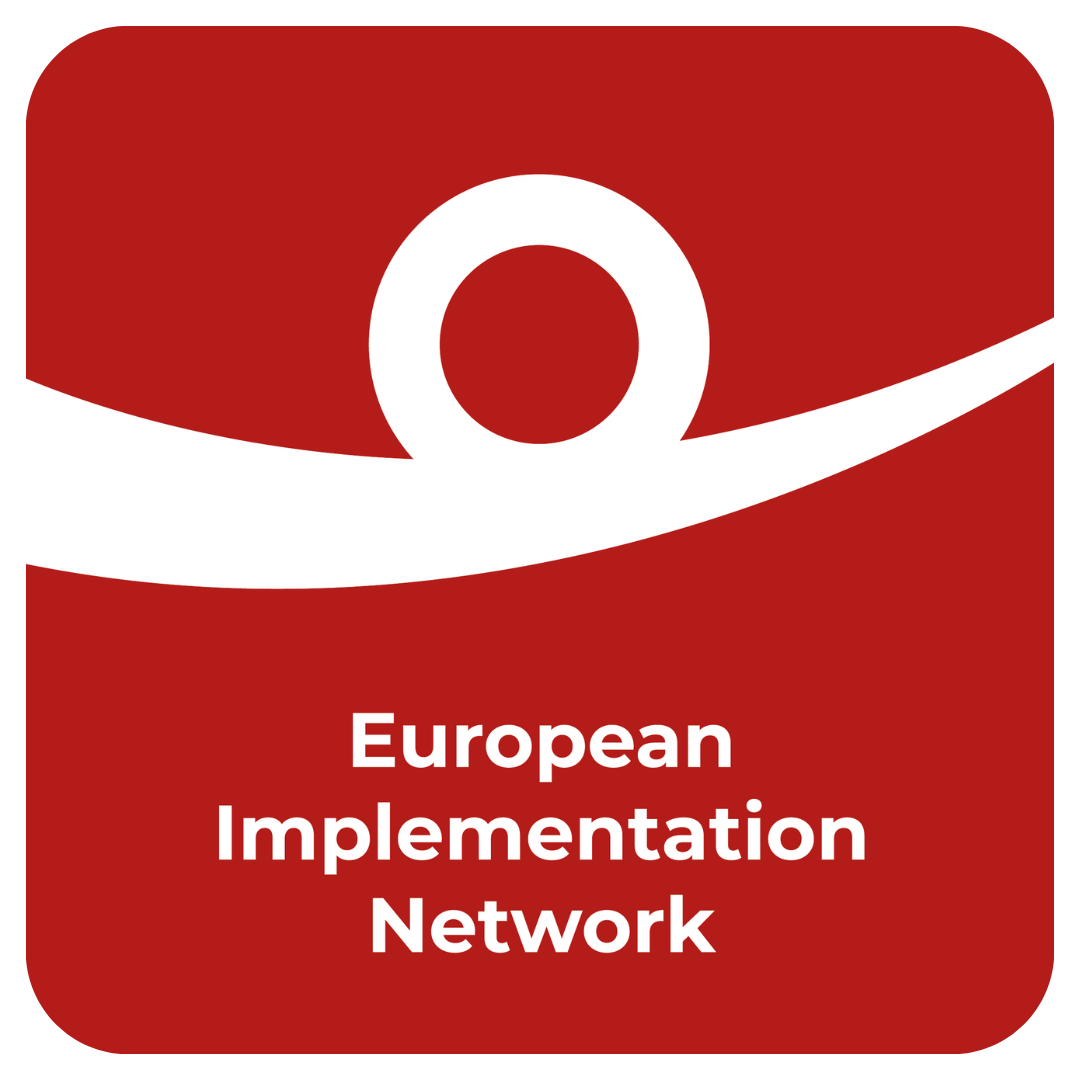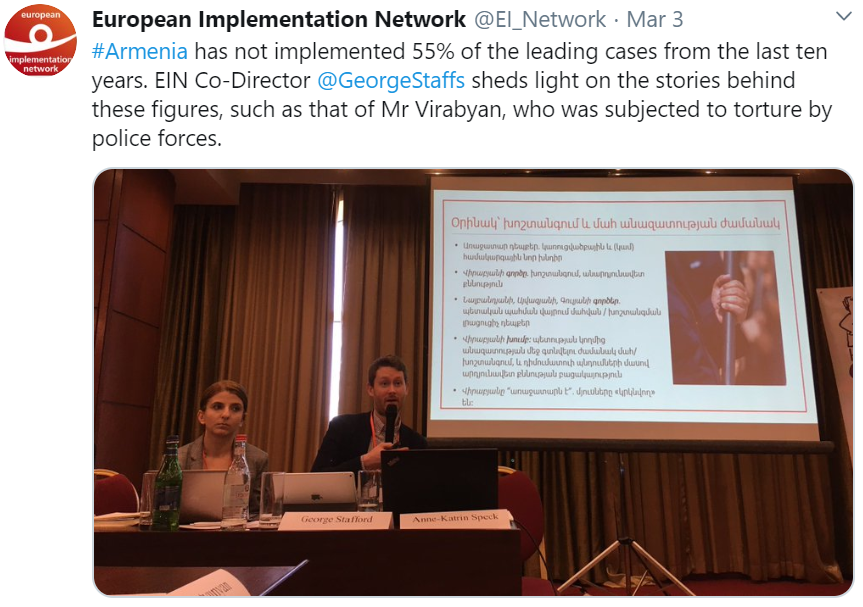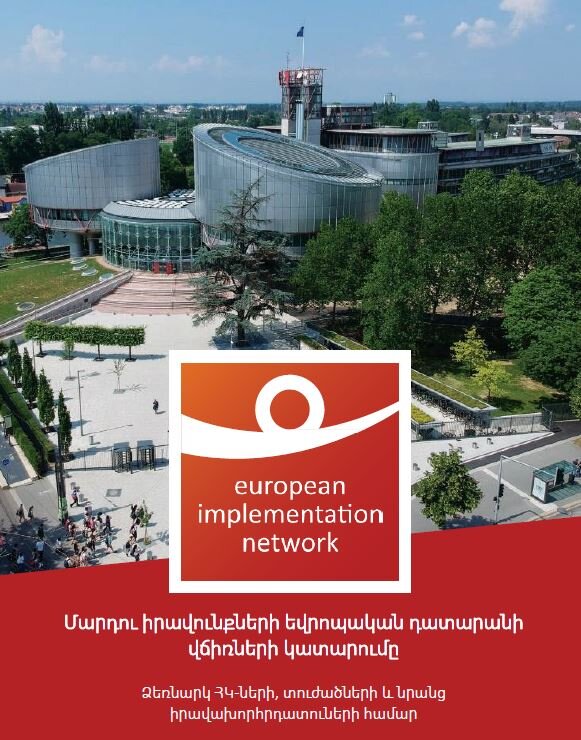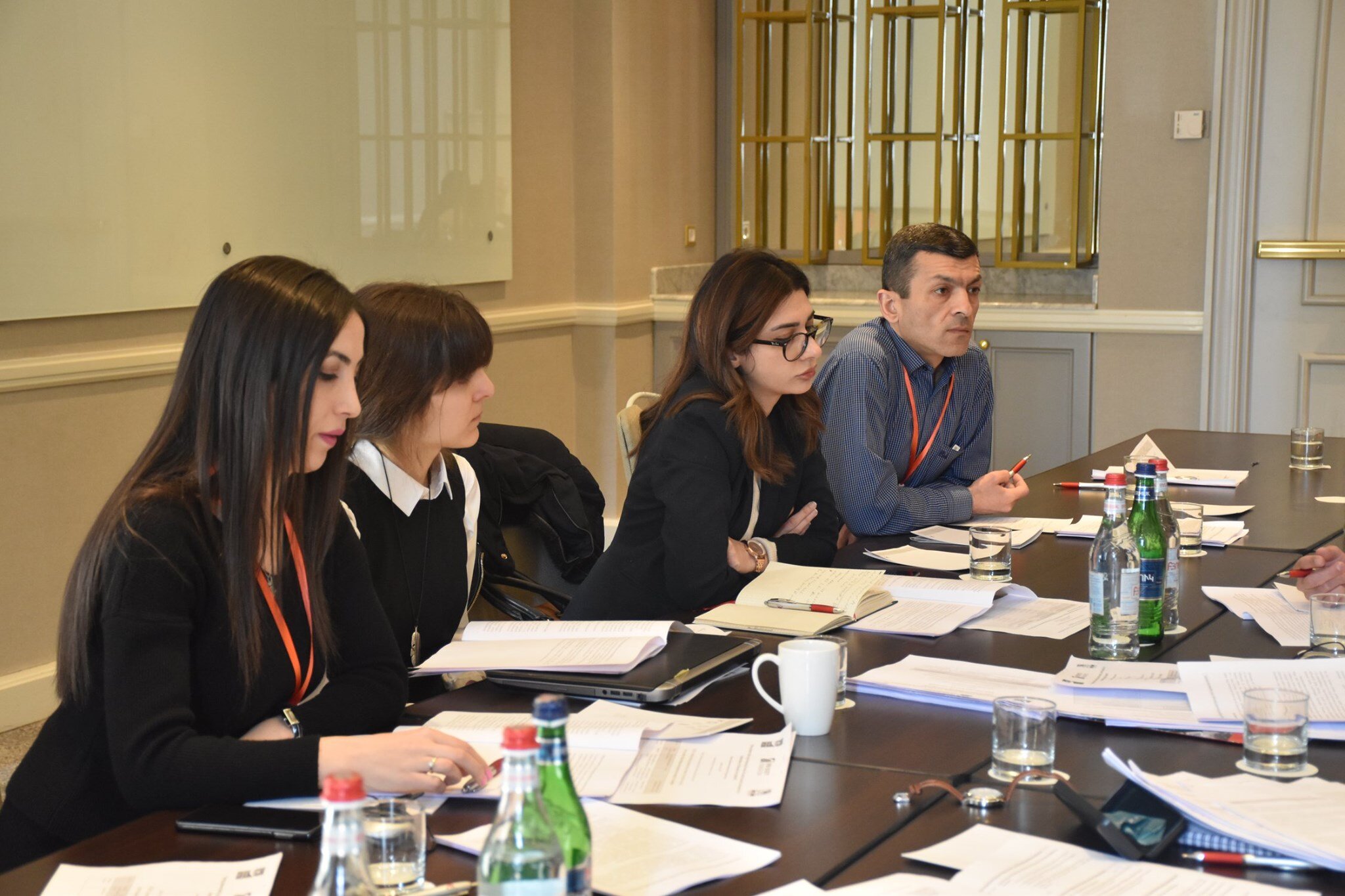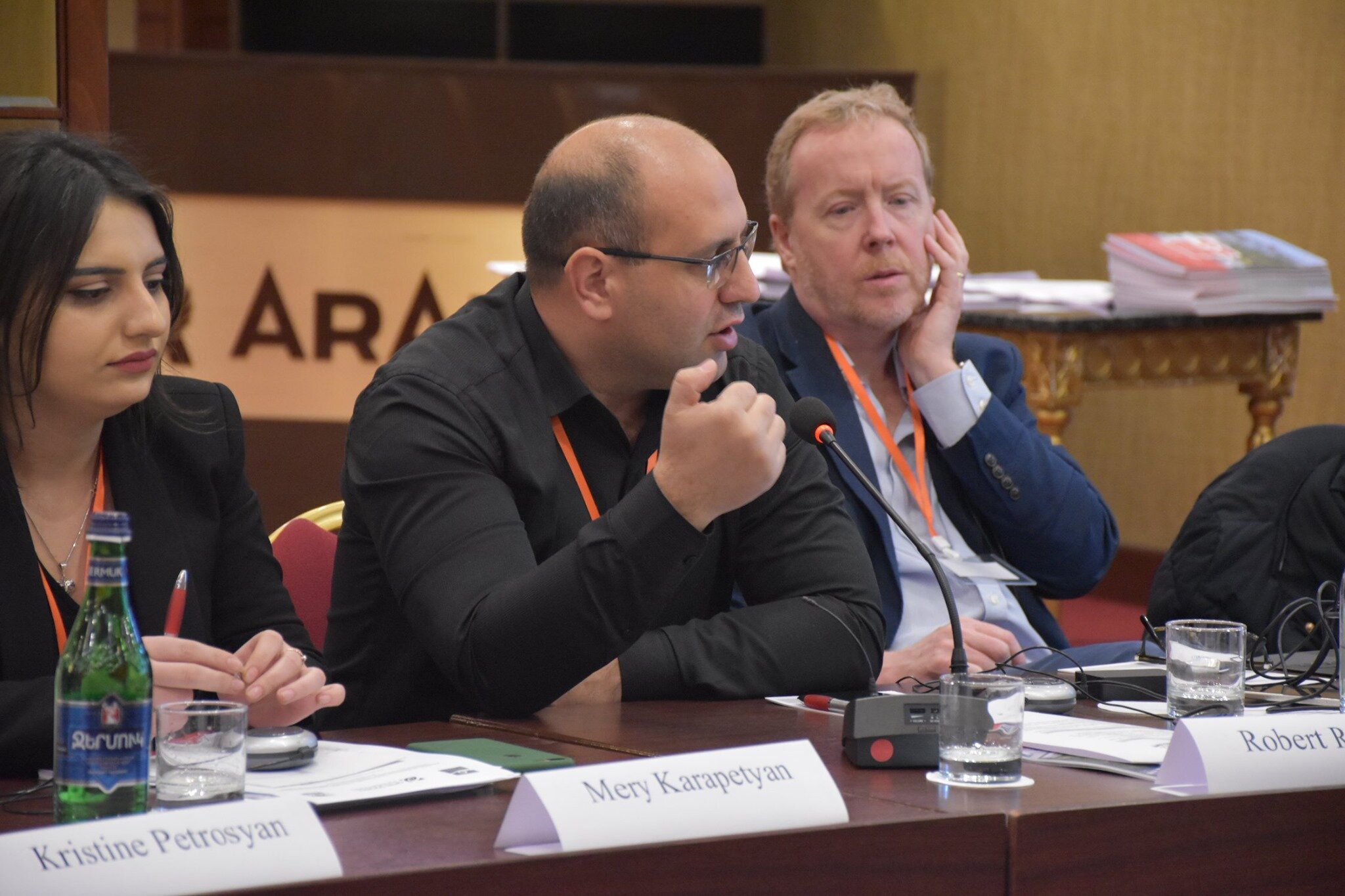EIN trains Armenian civil society actors in tackling implementation challenges
/Discussions with NGOs and authorities center on forming advocacy coalitions to bring about urgently needed reforms
Two years after the Velvet Revolution: Armenia’s record of implementing ECtHR judgments
Anyone looking at Armenia from the outside may be quick to assume that the window of opportunity created by the Velvet Revolution, which saw a mass protest movement bring down a quasi-authoritarian regime, would guarantee swift and measurable improvements in human rights protections that find their reflection in the closure of a number of the leading cases against Armenia pending implementation. Yet, while there seems to be political will to make the process of implementing Strasbourg Court judgments more effective, civil society is still waiting for profound reforms capable of resolving some of Armenia’s most systemic and widespread human rights violations. So, too, is the Committee of Ministers, which supervises the execution of no fewer than 20 leading cases – that is cases revealing new and often structural or systemic problems – against the Republic in the South Caucasus.
56 percent of the leading cases from the last ten years are still pending implementation, making Armenia score below average (across Europe, 43 percent of leading cases from the last ten years are not fully implemented).
Picture: ©HCAV
These cases cover a variety of issues, ranging from disproportionate and unnecessary dispersal of peaceful protests (Mushegh Saghatelyan v. Armenia) to torture in police custody and killings during arrest operations (Virabyan v. Armenia) to human rights abuses in the army (Muradyan v. Armenia) and inadequate medical care in detention (Ashot Harutyunyan v. Armenia). Several of them call for the adoption of a whole set of different measures, including judicial reform, trainings and other measures aimed at changing long-standing practices and attitudes. Strikingly, almost half (nine out of 20) of the pending leading cases have not been subject to a Government Action Plan.
Enhancing civil society capacity to promote the implementation of judgments
At the same time, civil society engagement in the implementation process has to date been relatively low in Armenia: only two Rule 9.2 submissions were made in the past twelve months, and participants noted that meetings between NGOs and the Government Agent were rare. They added that media coverage seldom, if ever, extended beyond reporting on a new judgment from Strasbourg to include an implementation dimension. It appeared, then, that more could be done to enhance Armenian civil society’s capacity to effectively advocate for the implementation of Strasbourg Court judgments.
This was objective of EIN’s training workshop on 3 March, which brought together 23 NGO representatives and lawyers from both Yerevan and the regions to introduce them to the Committee of Ministers’ (CM’s) judgment execution process and ways for civil society to get involved in it.
Why advocate for the implementation of judgments?
Picture: ©HCAV
The participants needed little convincing that advocacy for judgment implementation is a powerful tool to trigger and shape urgently needed reforms. The Strasbourg Court is generally held in high esteem by the authorities and the public. Because of this, participants agreed, being able to point to a judgment from the European Court of Human Rights could help both civil society actors and conscientious domestic decision-makers overcome resistance to change. Indeed, several participants said they would want to see the Court use more prescriptive and specific language in its rulings. This, in turn, underscores the importance for litigating organisations of starting to think about implementation already at the litigation stage, and invite the Court to provide clear guidance on remedies.
The EIN team was also able to point to cases illustrating how Strasbourg Court rulings have translated into tangible human rights improvements in Armenia. Take the case of Mr Bayatyan, a young Jehova’s Witness who was convicted of draft evasion for refusing to do military service on account of his deeply held beliefs. He was sentenced to over two years’ imprisonment. Subsequently, Armenia strengthened the rights of conscientious objectors. This case also shows how important it is for civil society to keep on pushing for implementation: here, an NGO made two Rule 9 submissions to the Committee of Ministers, calling for reforms.
How to push cases forward – domestically and through Strasbourg?
How to make such submissions, when best to do so, how to structure them, what recommendations to include, and what evidence to present was discussed in detail during EIN’s training. The event also saw the launch of the brand-new Armenian version of EIN’s Handbook on Rule 9 submissions.
Great attention was moreover devoted to advocating domestically for the implementation of judgments: by meeting with the Government Agent and other relevant authorities to feed into the drafting of initial action plans; sensitising the public to the need for reform; generating media coverage of non-implementation problems; and collecting evidence of ongoing violations.
The workshop provided a forum for brainstorming how to engage with various interlocutors at the domestic level to strengthen coordination and cooperation and thus make the implementation process more effective and efficient. A first step towards this aim, it was agreed, would be for a group of volunteers to prepare and disseminate a brief analysis of the state of implementation of the 20 leading cases, highlighting the outstanding issues and identifying who needs to take action to ensure the necessary measures are adopted. The plans thus developed fed into group discussions on how to advance the implementation of three (groups of) cases pending implementation, domestically and through advocacy in Strasbourg.
Towards closer civil society cooperation for implementation advocacy
A recurring theme emanating from our brainstorming was the need to better coordinate the efforts of the many civil society organisations that are willing to be involved in implementation monitoring and advocacy. It was very encouraging to see, against this backdrop, that several participants decided on the day of the event that they would set up a working group to devise a holistic advocacy strategy to promote the implementation of Muradyan v. Armenia, concerning a wide-spread problem of human rights abuses in the army, including shocking numbers of non-combat deaths in the military.
Picture: ©HCAV
But the plans did not stop there. A major conclusion of the workshop, consolidated through subsequent bilateral discussions, was that a civil society platform would be created to function as an ‘implementation hub’ in Armenia: by getting involved early in the implementation of new cases in order to influence its very trajectory and the scope of implementation matters; functioning as a contact point for the authorities, the media, and EIN; keeping a log on timelines for reporting to the Committee of Minsters; preparing reports, briefings and other resources relating to (non-)implementation; coordinating the drafting of joint Rule 9 submissions; ensuring the systematic collection of data about the adequacy of implementation measures; pushing for the strengthening of implementation mechanisms; and generally enhancing knowledge and awareness of the implementation process.
What role for other stakeholders? The importance of forming advocacy coalitions
Such improved coordination among civil society, it was felt, would also facilitate engagement with the authorities. And indeed, implementation of judgment requires a concerted effort by the executive, legislative and judicial branches of government; civil society; ombudsman institutions; and media outlets capable of informing wider segments of society about the obligations flowing from ECtHR judgments and shaping public opinion.
Picture: ©HCAV
To highlight this ‘shared responsibility’ for judgment implementation and hear from representatives of the various institutions that have a stake in ensuring that Armenia complies with the rulings from Strasbourg, EIN organised an open debate in the morning of 4 March. The debate, which was moderated by EIN Vice-Chair Professor Philip Leach and covered by no fewer than three TV outlets (for a video of the live-stream, see here), saw the participation of
Mr Liparit Drmeyan, Head of the Office of the Agent of the Republic of Armenia to the ECtHR
Mr Serjik Avetisyan, Judge at the Court of Cassation,
Ms Arpi Sargsyan, representative of the Anti-corruption and Penitentiary Policy Department of the Ministry of Justice,
Ms Gohar Simonyan, Coordinator of the National Preventive Mechanism and Head of the Department for Prevention of Torture and Ill-Treatment at the Office of the Human Rights Defender of the Republic of Armenia,
Ms Zaruhi Mejlumyan, Attorney-at-Law, formerly associated with Investigative Journalists of Armenia (Hetq), and
Ms Mariam Antonyan, Legal Analysis and Initiatives Coordinator, Helsinki Citizens’ Assembly Vanadzor.
EIN’s thread of live-tweets from the event reflects the diversity of the issues discussed – ranging from positive examples of successful judgment implementation in Armenia to specific ongoing and outstanding judicial reforms needed to address torture at the hands of state agents. An encouraging signal from the panel was to see the representatives of the authorities expressing their unreserved desire to closely involve civil society in initiatives aimed at strengthening the implementation process, including an inter-agency platform the Government Agent was planning to set up to help coordinate ECtHR judgment implementation across the government.
The EIN team left Yerevan heartened by the level of civil society commitment to promoting a range of reforms necessary to ensure full implementation of the Strasbourg Court’s judgments in Armenia. We look forward to continuing our cooperation with our Armenian members and partners.
EIN would like to thank our colleagues from Helsinki Citizens’ Assembly Vanadzor and OSF for their invaluable support in organising these events, which were funded by OSF Eurasia. We should also like to thank the representatives of the Office of the Government Agent, the National Assembly, the Ministry of Justice, the Ombudsman’s Office, and of OSF Armenia as well as the latter’s Strategic Litigation Program with whom we were able to hold constructive bilateral meetings to discuss concrete ways to strengthen the ECtHR judgment implementation process in Armenia.
Picture: ©HCAV
